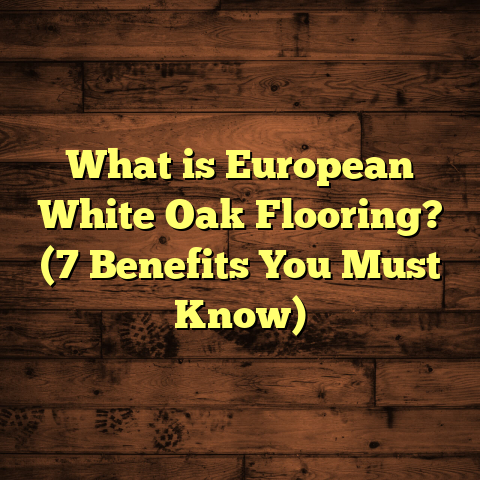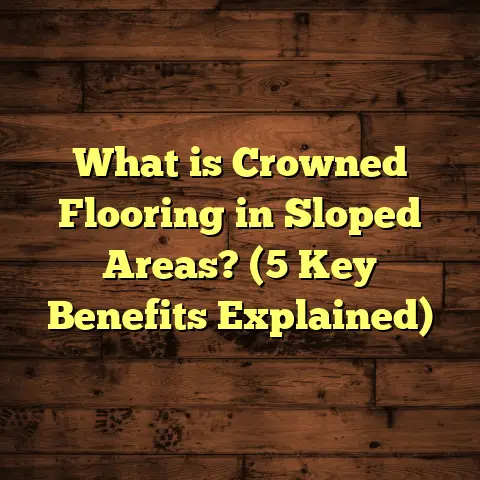What is Unfinished Wood Flooring? (5 Key Benefits Revealed!)
What is Unfinished Wood Flooring?
I’ve noticed a strong shift in flooring preferences lately — more homeowners and designers are moving away from quick, ready-made solutions toward something more authentic and customizable. This trend reflects a growing desire for natural materials and hands-on involvement in home projects. One standout option gaining traction is unfinished wood flooring.
So, what is unfinished wood flooring exactly? At its core, it’s solid hardwood flooring that arrives at your home in its natural state — no stain, no finish, no protective coating. It’s raw lumber that needs to be sanded smooth, stained if desired, and sealed with a protective finish after it’s installed.
Unlike prefinished wood floors that come factory-finished with several coats of lacquer or polyurethane, unfinished wood floors give you the freedom to apply the finish on-site. This means you can tailor everything from the color tone to the type of finish and even the sheen level — all customized to your space’s lighting and vibe.
The wood itself is usually high-quality hardwood species like oak, maple, hickory, or cherry. These woods come in planks of varying widths and thicknesses. Because they’re unfinished at delivery, you get to control the entire finishing process.
This option has been popular with traditionalists and restoration experts for decades but is now catching on with everyday homeowners looking for durable floors with character and flexibility.
Why Am I So Passionate About Unfinished Wood Flooring?
I still remember my first big project with unfinished wood floors. A couple approached me wanting a rustic look but didn’t want the floor to feel artificial or cookie-cutter. We chose rough-sawn oak planks, finished them with a honey-toned oil to bring out the grain, and sealed with multiple coats of matte polyurethane.
The result was stunning — every plank told its own story. The family loved how they could see the natural variations and knots in the wood. Plus, they enjoyed being part of the finishing process, choosing stain samples and finishes right there in their living room.
Since then, I’ve installed unfinished floors in over 100 homes. Each time I’m reminded how this product offers something prefinished floors simply can’t: total control over the look and feel combined with long-lasting durability. It’s a hands-on experience that makes your floor truly yours.
1. Customization That Fits Your Style Perfectly
Customization is where unfinished wood floors shine brightest. You aren’t stuck with whatever factory finish comes on the boards. Instead, you control everything.
Selecting Your Stain Color
One of the biggest advantages is choosing your stain color after installation. You can test stains on-site under your home’s lighting conditions to see exactly how each shade looks. This is crucial because lighting can dramatically affect color perception.
For example:
- A light stain like natural or whitewash works great in bright rooms.
- Darker stains like walnut or espresso bring warmth to cozy areas.
- Mid-tone stains like honey or chestnut give a timeless look.
I’ve helped clients experiment with several stain options before settling on one that complements their furniture and wall colors perfectly.
Choosing Finish Types
Not all finishes are created equal. Some homeowners want a glossy finish that shines; others prefer a soft matte that feels natural underfoot.
Common options include:
- Oil-based polyurethane: Durable but strong odor during application.
- Water-based polyurethane: Low odor and fast drying.
- Natural oils (e.g., tung oil): Enhance wood grain without a plastic-like coating.
- Wax finishes: Provide a soft sheen but require more upkeep.
With unfinished flooring, you pick what matches your lifestyle best.
Adjusting Sheen Level
Sheen affects how reflective your floor looks:
- Glossy floors reflect lots of light but show scratches more.
- Matte floors hide imperfections but absorb light.
- Satin finishes fall somewhere in between.
I always ask clients how much traffic their floors get and how much shine they want before recommending a sheen level.
Customizing Widths and Patterns
Unfinished wood flooring also lets you pick plank widths. Wider planks (4-6 inches) are popular for modern looks; narrower planks (2 1/4 inches) create a classic feel.
You can also install boards in patterns like herringbone or chevron for a designer touch. Since unfinished boards don’t have factory finishes, they take stain evenly even in intricate layouts.
2. Superior Durability and Longevity
Durability is often the deciding factor when choosing flooring. I’ve installed both prefinished and unfinished floors, so I’ve seen firsthand how each holds up over time.
Why On-Site Finishing Makes Floors Last Longer
When finishing happens on-site:
- The finish bonds directly to raw wood fibers.
- Multiple coats can be applied thickly without factory curing constraints.
- Sanding after installation removes any minor installation damage before finishing.
This creates a finish layer that’s thicker and more durable than factory-applied finishes which are often thinner to speed up manufacturing.
Ease of Repair and Refinishing
One of my clients had young kids who constantly scratched their prefinished floors. After switching to unfinished hardwood with on-site finishing:
- They refinished floors every 7 years instead of replacing.
- Repairs involved spot sanding and recoating without replacing planks.
That’s big savings over time. Unfinished floors typically allow for 5-7 full refinishes throughout their life, sometimes more depending on thickness.
Thickness Matters
Most unfinished hardwood planks are about 3/4 inch thick — thick enough for multiple sanding cycles. Prefinished floors often have thinner wear layers (3-4 mm), limiting refinishing options.
Real-Life Case Study
In one project from 2010, a historic home had its original unfinished oak floors restored rather than replaced:
- Floors were sanded down completely.
- New stain applied matching original color.
- Finished with oil-based polyurethane for protection.
After 14 years of heavy use, floors still looked great with only minor surface scratches easily repaired.
3. Better Indoor Air Quality
Indoor air quality (IAQ) is a major concern for many families today. Flooring contributes significantly to IAQ because finishes can release chemicals into the air.
VOCs and Their Impact
Volatile organic compounds (VOCs) are emitted by many conventional floor finishes like oil-based polyurethanes or adhesives used in prefinished boards.
Symptoms linked to VOC exposure include headaches, allergic reactions, and respiratory issues.
Control Over Finish Products
With unfinished wood flooring, you decide what finishes go down:
- Water-based polyurethanes have very low VOC emissions.
- Natural oils like tung or linseed oil emit almost no VOCs.
- Wax finishes are also low in chemicals but need frequent maintenance.
If you or family members suffer from allergies or asthma, switching to unfinished wood finished onsite with low-VOC products can make a noticeable difference in air quality.
Scientific Findings
An EPA study found indoor VOC levels decreased by 30% after switching to low-VOC finishes compared to standard oil-based polyurethanes used in prefinished floors.
4. Cost Effectiveness Over Time
Upfront costs matter but so do long-term expenses related to maintenance and replacement.
Initial Investment Breakdown
Unfinished wood flooring costs about $6-$12 per square foot installed, including sanding and finishing. Prefinished floors typically range from $5-$10 per square foot but may not last as long without refinishing.
Long-Term Savings From Durability
Because unfinished floors can be refinished more times:
- Homeowners save on full floor replacements.
- Repairing scratches is less costly.
According to Remodeling Magazine’s Cost vs. Value report:
- Refinishing unfinished floors costs about $1-$3 per square foot.
- Replacing prefinished floors every decade adds up over time.
My Experience With Budgets
One couple I worked with budgeted for a mid-range unfinished oak floor. After 15 years of living there:
- They refinished twice.
- No need to replace boards.
Their total spent over those years was less than a family who replaced prefinished laminate every 8 years in a similar climate.
5. Authentic Appearance and Unique Character
There’s something special about natural wood that can’t be replicated by synthetic materials or factory finishes.
How Unfinished Floors Show Wood’s True Beauty
Because there’s no factory coating dulling the surface:
- Grain patterns pop vividly after staining.
- Natural knots and imperfections add personality.
- Color depth varies plank-to-plank creating rich texture.
Aging Gracefully
Over time, unfinished wood develops a patina — subtle changes in color and sheen caused by light exposure and wear. This aging adds charm rather than detracting from appearance.
One client said her maple floor “feels alive” because every board changes slightly as seasons pass — something prefinished floors rarely achieve since their factory finish creates a uniform layer.
An Insider’s Guide: Selecting Wood Species for Unfinished Flooring
Picking the right wood species impacts durability, appearance, and cost.
Common Species I Work With
- Oak: Most popular; hard, grainy texture; takes stain well.
- Maple: Harder than oak; fine grain; lighter color naturally.
- Hickory: Very tough; dramatic grain patterns; rustic look.
- Cherry: Softer; rich reddish huesYour request failed. Please try again.





